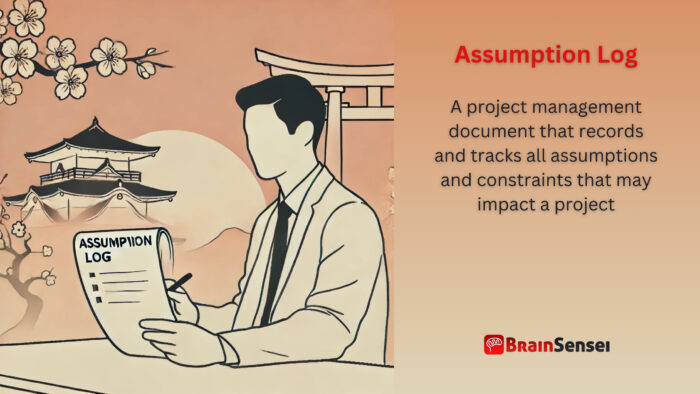
Assumption Log
What is an Assumption Log?
An assumption log is a project management document that records and tracks all assumptions and constraints that may impact a project. It helps project managers document, validate, and review assumptions throughout the project lifecycle to mitigate risks and enhance decision-making.
Key Takeaways
- An assumption log records assumptions, constraints, and dependencies affecting a project.
- It helps identify potential risks and uncertainties early in the project.
- The log is updated regularly as new information emerges.
- It serves as a reference for stakeholders to align expectations and decisions.
- Properly managed assumption logs contribute to better project planning and execution.
Understanding the Assumption Log
How It Works
An assumption log is created at the beginning of a project during the planning phase and maintained throughout the project’s duration. Assumptions refer to factors believed to be accurate but not yet validated, while constraints are limitations imposed on the project (e.g., budget, schedule, or resources).
Components of an Assumption Log
- Assumption ID: Unique identifier for tracking.
- Description: A clear statement of the assumption.
- Category: Classification based on impact (e.g., technical, financial, operational).
- Owner: The person responsible for monitoring the assumption.
- Date Logged: When the team recorded the assumption.
- Impact Assessment: Potential risks or consequences.
- Validation Status: Confirmed, pending validation, or disproven.
- Resolution Strategy: Actions to validate or mitigate risks.
Notes
- Teams should validate assumptions regularly to avoid unexpected issues.
- Unchecked assumptions can lead to project failure if proven incorrect.
- Stakeholders should review the assumption log to ensure alignment.
- Project managers should integrate it with the project’s risk management process.
- Changes in project scope or environment may require updating the log.
Related Terms
- Risk Register: A document that records identified risks, their impact, and mitigation strategies.
- Issue Log: A record of project-related problems that need resolution.
- Change Log: Tracks changes in project scope, schedule, or resources.
- Project Charter: An official document authorizing a project and outlining key assumptions.
- Lessons Learned Register: Captures insights from past projects, including incorrect assumptions.
Examples of Assumption Log Use in Different Industries
Construction Industry
A construction project assumes that local authorities will approve permits within four weeks. The assumption log records this expectation and contingency plans in case of delays. However, unforeseen bureaucratic issues extend the approval timeline to eight weeks, impacting the project schedule. Since the assumption log captured this assumption early on, the project manager had already planned buffer time into the schedule and adjusted resource allocation to prevent significant disruptions.
Additionally, The team assumed suppliers would deliver raw materials on time. However, supply chain disruptions caused a shortage of key materials. Because the team tracked this assumption, they quickly shifted to alternative suppliers to keep the project on track.
IT & Software Development
An IT team assumes a new software tool will seamlessly integrate with existing systems. The assumption log helps track validation steps and potential risks if integration issues arise. In this case, initial tests showed compatibility issues between the new tool and legacy systems, requiring extensive modifications to the API structure. Since they recorded this risk in the assumption log, the team planned extra development time for troubleshooting, thus avoiding costly delays.
Furthermore, another assumption stated that the software development team would remain fully staffed throughout the project. However, two key developers resigned midway through, causing setbacks. Because the team anticipated this possibility in the assumption log, they had a contingency hiring plan to quickly onboard replacements and maintain progress.
Healthcare Sector
A hospital project assumes a key supplier will deliver medical equipment on time. The assumption log allows for proactive risk management if delays occur. In this case, unforeseen manufacturing disruptions cause a two-month delay in equipment delivery, affecting the hospital’s launch date. Since the assumption log included backup suppliers as a mitigation plan, the project team quickly secured an alternative vendor, minimizing the impact.
Additionally, the team assumed that regulators would approve new medical procedures within six months. However, changes in healthcare policies extended this timeline, requiring adjustments to the project schedule and additional compliance documentation. Because the hospital’s project team logged and regularly reviewed this assumption, they had already allocated extra time for regulatory approvals, preventing unexpected last-minute delays.
Use Cases of Assumption Log Implementation
Canada (Infrastructure Development)
A transportation project in Canada assumes that the government will secure funding approvals within six months. The assumption log helps the project team plan alternative funding strategies. However, unexpected political changes delay the approval process. Because the project team tracked this assumption, they had already developed an alternate financing strategy and secured short-term loans to keep progress on track while awaiting approval.
The team also assumed that authorities would issue environmental permits without objections, but community opposition led to extended ecological impact assessments. Because the team accounted for this risk, they had planned additional time for negotiations and community engagement, ensuring minimal disruptions.
Germany (Renewable Energy Project)
A wind farm project in Germany assumes that weather conditions will remain stable for turbine installation. The assumption log ensures that contingency measures are in place for delays. However, unseasonal storms halt construction for several weeks, impacting the project timeline. Since the assumption log included alternative schedules and extra workforce availability, the project quickly adjusted and avoided significant cost overruns.
Another key assumption was that government subsidies for renewable energy projects would remain unchanged. However, a policy shift in the mid-project reduced subsidies, affecting the budget. Because the team recorded this assumption, they had a secondary financial plan ready, allowing the project to continue without significant financial strain.
China (Manufacturing Expansion)
A manufacturing firm in China assumes that raw material costs will remain stable. The assumption log tracks economic trends and enables cost-control strategies. However, unexpected global supply chain disruptions cause material costs to rise sharply. Because the team documented this risk in the assumption log, they had already negotiated flexible contracts with alternative suppliers, minimizing financial losses.
Another assumption was that factory workforce availability would remain consistent. However, due to changing labour laws, the factory faced worker shortages. Since the assumption log had anticipated this as a potential risk, management had a hiring contingency plan in place, ensuring that production schedules remained unaffected.
Best Practices for a Successful Implementation of an Assumption Log
Clearly Define Assumptions and Validate Them Early
To maintain an effective assumption log, teams must clearly define all assumptions at the beginning of the project. Project managers document who made the assumption, its potential impact, and the factors influencing it. Teams should validate assumptions as early as possible to avoid significant project risks.
Regularly Review and Update the Assumption Log
Teams should not treat an assumption log as a static document. They must review it regularly to ensure they update or remove outdated or disproven assumptions. Project teams should schedule periodic reviews to confirm the validity of assumptions and update mitigation strategies accordingly.
Align Assumptions with Stakeholder Expectations
Stakeholders are crucial to project success. To avoid conflicts and misunderstandings, all assumptions must align with stakeholders’ expectations. Project managers should communicate assumptions clearly and ensure stakeholders acknowledge and agree on them.
Integrate Assumption Tracking with Risk Management
Since incorrect assumptions can lead to significant project risks, teams should integrate assumption tracking into the project’s risk management plan. They should also assess identified assumptions for risk level, scrutinize high-risk assumptions, and develop mitigation plans.
Document Resolutions for Future Project Learnings
Documenting the resolution process when assumptions are validated or disproven can provide valuable lessons for future projects. This historical data can help teams refine their assumption-tracking strategies and improve overall project management practices.
Establish Ownership and Accountability
Each assumption should have an assigned owner responsible for monitoring its validity. This approach ensures that teams track and update assumptions as new information becomes available. Assigning ownership also prevents assumptions from being overlooked until they cause issues.
Use Data-Driven Decision Making
Project teams should use data to validate assumptions whenever possible. Relying on industry trends, historical data, and expert insights can improve the accuracy of assumptions and reduce uncertainty. Data-driven decision-making can help teams make informed adjustments throughout the project lifecycle.
Foster a Culture of Continuous Improvement
Project teams should view assumption management as an ongoing process rather than a one-time activity. Encouraging a continuous improvement mindset allows teams to refine their approach to tracking and validating assumptions, leading to better project outcomes.
Conduct Scenario Planning for High-Impact Assumptions
Scenario planning can be helpful for assumptions with potentially high consequences. Teams should create contingency plans outlining potential responses if an assumption proves incorrect. Having pre-defined action plans can significantly reduce project delays and disruptions.
Leverage Technology for Better Assumption Management
Modern project management tools and software offer features that can streamline assumption tracking. Utilizing digital tools to log, monitor, and analyze assumptions can improve efficiency and ensure all project team members can access the latest assumption data.
Encourage Open Communication and Collaboration
Project assumptions often involve multiple departments and stakeholders. Encouraging open communication and collaboration ensures that all relevant parties know the assumptions and can contribute insights that may improve assumption validation and risk management.
Monitor External Factors That May Affect Assumptions
Teams do not make assumptions in a vacuum. External factors such as economic conditions, regulatory changes, and technological advancements can influence project assumptions. Project managers should stay informed about external developments and adjust assumptions accordingly.
Establish a Structured Assumption Review Process
Teams should establish a structured review process to maintain a reliable assumption log to maintain a reliable assumption log. This process may include scheduled assumption reviews, designated reviewers, and defined criteria for updating or removing assumptions from the log.
Provide Training on Assumption Management
Many project managers and team members may not be familiar with best practices for assumption management. Providing training and resources on documenting, validating, and tracking assumptions can improve overall project execution and reduce risks.
Measure the Impact of Assumptions on Project Outcomes
After completing a project, teams should assess how assumptions influenced the outcomes. Identifying which assumptions were accurate and which caused challenges can provide insights that improve assumption management for future projects.
Assumption Log: Common Mistakes and Issues
One of the most frequent mistakes in project management is failing to validate key assumptions early in the project lifecycle. Many project managers assume that external dependencies, such as regulatory approvals or third-party vendor deliverables, will proceed as planned without actively verifying these elements. This oversight can lead to project delays, cost overruns, or failure.
Another issue is the lack of stakeholder engagement in reviewing and updating the assumption log. If assumptions are not regularly revisited and validated, outdated information can create misalignment between project teams and stakeholders, resulting in unrealistic expectations and friction during project execution.
A common pitfall is assuming a project’s initial assumptions will remain valid throughout its lifecycle. Projects operate in dynamic environments where market conditions, economic factors, and technological advancements can shift rapidly. If teams fail to reassess assumptions periodically, they risk basing critical decisions on outdated information.
Furthermore, many organizations do not integrate their assumption logs with risk management frameworks. As a result, teams leave assumptions that should be flagged as potential risks unchecked. For instance, assuming a supplier consistently delivers materials on time without a contingency plan can lead to severe disruptions if supply chain issues arise.
Another challenge is the failure to assign clear ownership for tracking assumptions. Without accountability, assumptions often go unmonitored, leading to unexpected risks surfacing at critical project milestones. Assigning clear ownership to specific team members ensures ongoing validation and risk mitigation.
Projects with international stakeholders often fall prey to cultural and regulatory assumptions. For example, assuming that business practices in one region align with those in another without adequate research can lead to compliance issues and operational setbacks.
Technology-related projects frequently assume that software or hardware integrations will be seamless without thorough testing. If unexpected compatibility issues arise, this assumption can lead to significant delays. Technical teams need to validate assumptions through rigorous testing before full implementation.
Financial miscalculations are another significant issue. Project teams may assume stable material costs, steady currency exchange rates, or predictable labour costs, only to encounter volatile market conditions. Failing to anticipate financial fluctuations can have severe budgetary consequences.
A classic example of assumption failure is in large-scale infrastructure projects. Many projects assume that environmental assessments will clear regulatory requirements within a predefined timeframe. However, unexpected public opposition or new ecological regulations can significantly extend the approval process, causing significant setbacks. Having contingency plans in place for regulatory delays can help prevent project standstills.
Another example involves agile software development teams that assume end-users will accept a new product without resistance. Suppose user feedback is not incorporated early in the process. In that case, organizations may end up with a product that does not meet customer needs, resulting in costly redesigns and decreased adoption rates.
Project managers should implement structured assumption review sessions to mitigate these issues, involve key stakeholders in the validation process, and integrate assumptions into risk assessment plans. Encouraging a proactive approach to monitoring and updating assumption logs can help projects navigate uncertainties more effectively and improve project success rates.
Assumption Log: Frequently Asked Questions (FAQs)
Why is an assumption log important in project management?
An assumption log helps track project uncertainties, enabling better decision-making and risk management.
How often should an assumption log be updated?
It should be updated regularly, especially when new assumptions arise, or existing ones are validated or disproven.
Who is responsible for maintaining the assumption log?
The project manager typically maintains the log, but input from stakeholders is essential.
What happens if an assumption is incorrect?
If an assumption proves incorrect, the project team must adjust plans accordingly and mitigate risks.
Can an assumption log be used in Agile projects?
Agile teams can use an assumption log to track evolving assumptions and ensure adaptability.
Additional Resources
- Fundamentals of Risk Management
- Project Assumptions: A Quick Guide
- Your ultimate guide to project assumptions
Preparing for a PMI certification?
- Exam Prep Courses: PMP®, CAPM®, and PMI-ACP®
- Exam Simulators: PMP®, CAPM®, PMI-ACP®, PMI-PBA®, PMI-RMP®, PMI-SP®, PgMP®, and PfMP®
- Professional Development Units (PDUs): 15, 30, and 60 PDU Bundles



